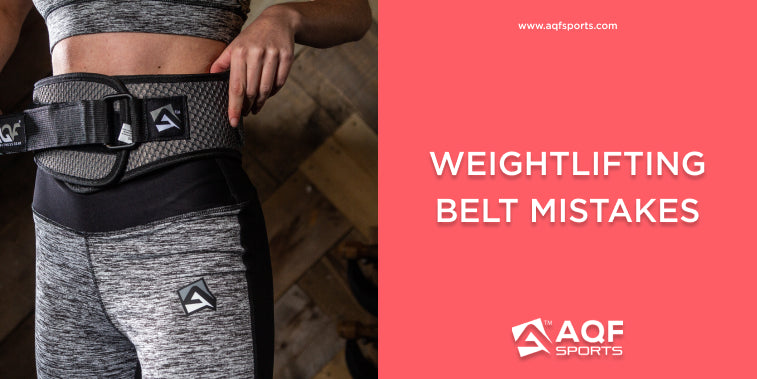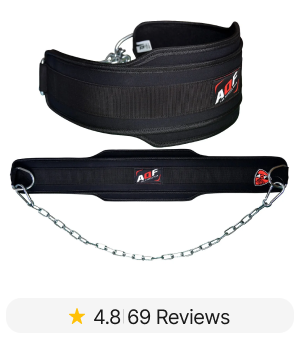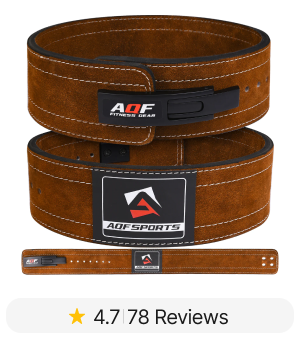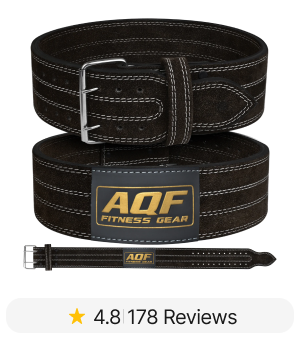The Common Weightlifting Belt Mistakes You Must Avoid for Better Results

Do you wonder why you are benefiting from wearing weightlifting belts? Are you sure you are wearing your belt the right way?
Weightlifting belts are important whether you are a powerlifter or a bodybuilder. It helps you maintain the right amount of pressure around your core. Still, many people are unaware of how to wear the weight lifting belt to benefit the most.
In this blog post, we will discover the mistakes you might be making with your lifting belt, and what measures you should take to rectify them. You will get all the information you need, to use your belt effectively.
Mistake #1: Over-Relying on Weightlifting Belt
Wearing a weightlifting belt constricts your waist around the midsection. This compression makes breathing challenging during lifting. As a result, you experience shallower breathing, which reduces oxygen intake for working muscles.
Weightlifting affects your ability to brace your core muscles. When lifting heavy weights, it’s crucial to take a deep breath and hold it to create intra-abdominal pressure and brace your core muscles. This pressure stabilizes the spine and prevents it from collapsing under the load weight.
Lifters over-rely on the weightlifting belt for core stability and forget bracing their core muscles properly. It increases chances of spinal injury and reduces weightlifting effectiveness.
Learn proper breathing technique for wearing a weightlifting belt. Take a deep breath into your stomach, not just your chest, and hold it while lifting. Focus on bracing your core muscles and maintain a proper spinal alignment throughout the lift.
Mistake #2: Choosing a Buckle Solely Based on Its Appearance
Weightlifting belt buckles play a significant role in determining your belt fitting and ease of use. When choosing a weightlifting belt buckle, check its functionality rather than solely relying on the looks.
Here are some common types of weightlifting belt buckles with their advantages and disadvantages for weightlifting:
Single Prong Buckle:
Advantages:
- Easy to adjust and loosen.
- Generally less expensive than other buckle types.
- Provides a secure fit and good support.
Disadvantages:
- Difficult to put on and take off than other buckle types.
- Becomes loose during heavy lifting, requiring frequent readjustment.
- Single prongs bend or break over time.
Ideal For:
Single Prong Buckles are budget-friendly options for beginner or intermediate lifters who are looking for a budget-friendly. They offer quick adjustment, good support and a secure fit.
Double Prong Buckle:
Advantages:
- Provides a secure fit and good support.
- Offers more stability than single prong buckles.
- Less likely to become loose during heavy lifting.
Disadvantages:
- More difficult to adjust and loosen than single prong buckles.
- May cause discomfort or dig into the skin.
- Double prongs may be less durable than other buckle types.
Ideal For:
Double Prong Buckles are suitable for advanced lifters who require more stability and support during heavy lifting. They take more time to adjust.
Lever Buckle:
Advantages:
- Easy to adjust and remove quickly.
- Provides a very secure fit and good support.
- Generally more durable than other buckle types.
Disadvantages:
- May be more expensive than other buckle types.
- Requires a tool to adjust or remove the belt.
- May cause discomfort or dig into the skin.
Ideal For
Lever Buckles are good for powerlifters and competitive lifters who require maximum support and a secure fit during their lifts.They are a more durable buckle type.
Velcro Buckle:
Advantages:
- Easy to adjust and remove quickly.
- Provides a secure fit and good support.
- Generally less expensive than other buckle types.
Disadvantages:
- May become loose during heavy lifting, requiring frequent readjustment.
- May lose its effectiveness over time due to wear and tear.
- Not as durable as other buckle types.
Ideal For:
Velcro Buckles is a pocket-friendly choice for beginner or intermediate lifters. They are moisture wicking and easy to adjust.
-

AQF Heavy Duty Dipping Belt with Metal Chain
£21.99
Buy Now -

AQF Lever Buckle Leather Powerlifting Belt 10mm
£34.99
Buy Now -

AQF Weight Lifting Nubuck Leather Power Belt
£22.99
Buy Now
Mistake #3: Not Being Patient Enough to Break Into New Weightlifting Belts
When you buy a new weightlifting belt, it may feel stiff and uncomfortable at the first try. This is because the leather or nylon material needs to be broken in for optimal use. However, some lifters are not patient enough during this process and use the belt before it has been properly broken in. It leads to stiffness and uncomfortable fitting.
Properly and gradually Breaking in a new weightlifting belt ensures optimal use and performance. Here are some tips on how to break in a new weightlifting belt:
- Wear it around for a few Hours: Before using the belt during a lifting session, wear it around for a few hours. This helps to mold the belt to your body and soften it up.
- Gradually Increase the Use: Start by using the belt for light lifting sessions and gradually mold it to your body and loosen up. Avoid using it for heavy lifting right away as this can cause discomfort and stiffness.
- Flex the belt: Flexing the belt in different directions loosen ups the material and makes it more flexible. Bend and twist the belt in various directions to enhance its stretch.
- Use a Leather Conditioner: Applying a leather conditioner to a leather belt to soften it up and prevent cracking.
- Hang the belt: Hang the belt up when not in use to prevent it from becoming stiffening and losing its shape.
Belt-Positioning Mistakes
Weightlifters usually make the mistake of wearing a belt where it seems comfortable or supportive. Wearing a belt too low on your hips or too high around your ribs is a common mistake you need to avoid.
Where to wear the weightlifting belt?
The best belt position is to place it right above your hip bone and make sure that the belt is in full contact with your lower back, the sides of your waist, and your abdominal muscles. You will get the most advantage from your belt by wearing the belt around the widest portion of your abdomen.
Positioning the Belt for Squats
When doing squats, you should wear your weightlifting belt directly over your belly button. If you position it any lower than this, the belt will interfere with your squat depth.
Positioning the Belt for Deadlifts
During the deadlift workouts, you should wear the belt a little higher on your body as compared to when performing squats. If you wear the belt a bit too low, it will restrict your deadlifts form leading you to lose lower back tightness. Improper form can also lead to a lower back injury.
Belt-Tightness Mistakes
Another mistake the weightlifters make is by tightening the belt to the point where you probably are strangling your core. You need to understand that tighter is not better, over or under tightening the belt can have adverse effects on your body while lifting.
Over-tightening the Belt
If you are wearing your belt like the ones you use to hold your pants up, stop! you are doing it all wrong! It usually happens when you tighten the belt on your waist circumference at rest and you are not breathing properly.
No Room to Breathe
If you are holding your breath while putting on your belt you are likely to leave no room for yourself to breathe out. If you are not leaving enough room for your stomach to expand when you breathe out, you will not be able to brace and create tension in your core muscles.
Ignoring Bloating
Bloating is normal and natural. If you do not accept the simple fact that your waist size can fluctuate in a day, you will be prone to make the mistake of wearing the belt on your usual, fixed spot. There is no constant spot!
What is the ideal belt tightness?
Make sure you are wearing the belt in the right position and place it above your hip bone and around your waist. Take a deep breath and clasp the belt while your stomach is relaxed so that you have enough room to breathe properly.
The belt should be tight but not too tight! A general rule of thumb is that you should be able to slide in your fingers with little effort. Make sure that your abs have enough belt space to push against during heavy lifts.
Ideal Belt Tightness for Squats
When doing weighted squats, usually people prefer to wear the belt tighter. One of the reasons is whilst doing squats most people wear the belt lower on the torso towards the hip bone. If the belt is too tight at the bottom of the squat, you may lose tension and will automatically feel a lack of power.
Ideal Belt Tightness for Deadlifts
When it comes to deadlifts, lifters usually prefer a looser fit in comparison to when performing squats. It is preferable to wear the belt a little higher, and closer to your waistline to avoid any unease the belt may cause.
Ideal Belt Tightness for Bench Press
The upper body muscles are involved in bench presses like pectorals, arms, and shoulders. Usually, powerlifters do not wear a belt when bench pressing. However, you can still wear the belt and you can wear it pretty tight because the bench press does not involve any folding or bending of the torso.
Are you activating your abs?
Let’s clear a misconception! Weightlifting belts are not only designed to support your lower back, they are also designed to help your abdominal wall, and help create intra-abdominal pressure. A lifting belt is used to increase the internal pressure in the abs. As a result, it allows you to lift heavier and for longer periods.
Intra-abdominal pressure helps you maintain spinal stability[1] and decrease spinal compression whilst reducing the chances of spinal injuries throughout the dynamic movements during your workout sessions.[2] Be it squats, deadlifts, or bench press exercises. For detailed information, you can also read how weightlifting belts work?
Are you using the right belt?
There are different types of belts, designed for specific purposes like powerlifting belts, velcro belts & bodybuilding training belts. The type of material used in belts also varies according to the type of lifting they are used for. The most popular types of weightlifting belts are leather, neoprene and nylon belts.
Make sure that the belt you choose aligns with your fitness goals. If you will be powerlifting, the belt you select should be suitable for power lifting like sturdy belts. Similarly, for an Olympic weightlifter, bodybuilder, or CrossFit the weightlifting belt must serve the purpose it has been designed for.
You may also find these guides helpful for choosing the right belt:
- Leather vs Nylon Lifting Belt! How to Choose the Right One?
- Powerlifting vs Weightlifting Belt: Which One Is For You?
Conclusion
It is challenging to know and properly use the weightlifting belts. But it is important to avoid common mistakes associated with the belts use, so that you don’t injure yourself in any way possible. They are designed to help you increase intra-abdominal pressure and reduce the likelihood of injuries. If you use them correctly, you will increase your chances of meeting your lifting goals more effectively.
Also Read: The Definitive Weightlifting Belts Guide
Reference:
[1]The use and abuse of Weightlifting Belts, Gaigenbaum, Avery D.
[2]A review of the use of lifting belts, Renfro, Gregory J.






